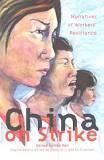Workers’ Stories of their Strikes in China
 China has the world’s largest population, about 1.4 billion people, with a working age population of about 950 million, hundreds of millions of them wage laborers. Most of us know little about the Chinese workers or the recent workers’ movement that has developed so rapidly, especially since the 1990s. Much less do we know anything about workers’ lives at work or on strike or what conclusions they have drawn from those experiences. We now have a remarkable book that introduces us to the Chinese worker.
China has the world’s largest population, about 1.4 billion people, with a working age population of about 950 million, hundreds of millions of them wage laborers. Most of us know little about the Chinese workers or the recent workers’ movement that has developed so rapidly, especially since the 1990s. Much less do we know anything about workers’ lives at work or on strike or what conclusions they have drawn from those experiences. We now have a remarkable book that introduces us to the Chinese worker.
China on Strike: Narratives of Workers’ Resistance is the product of an extraordinary collective endeavor by workers, leftists in the Chinese labor movement, and academics at universities in China and abroad—but it is above all a workers’ book about their workplaces and their work, about their bosses and government officials, about themselves and their co-workers, and what they think about it all. In 2010-2011, factory workers and Marxist-oriented students who also went to work in factories collected stories from their co-workers about their work lives, their involvement in strikes and protests, and the lessons that might be drawn from those experiences. Students at the International Center for Joint Labor Research at Sun Yat-sen University in Guangzho provided resources for this project. All of those who were interviewed were migrant workers, some of the 270 million migrant workers who toil in the factories of the Pearl River Delta, the heart of Chinese industry and labor.
Qin Ling provides a short (26-page) introduction to Chinese industry and workers from the 1990s to the present, a remarkably concise and informative year-by-year account of the changing political economy, development of industry, working conditions, legal structure, and working-class action. As Qin Ling describes the development of worker action—from individual fights between a single worker and a boss, to secret violent attacks on supervisors and owners, to group struggles between workers and companies but often aided by criminal gangs, to real collective action by workers—one realizes this is a rapid recapitulation of European and American labor history, though three centuries’ experience has been compressed into a few decades.
The book is then divided into three parts: struggles against factory closures, struggles against wage cuts, and struggles for wage increases. These chapters involve descriptions of industrial plants, workers autobiographies, accounts of job actions, strikes, and protests including workers’ interactions with foremen , supervisors, owners, labor authorities, lawyers, the media, and local government authorities. We learn about the different capitalist groups—Japanese, Taiwanese, and Chinese—and their increasing class consciousness expressed in reaction to the workers and to government legislation. We learn that many, perhaps most, of these workers are women, that it is economic conditions, above all wages, that provoke most strikes, that most of the strikes have a spontaneous character, that they are organized by cell-phone and photo apps, and that workers often have difficulty finding appropriate representatives and difficulty in formulating their demands. We see that workers lose many strikes and win some, but because of the government’s opposition they can almost never form stable labor organizations and therefore cannot create a labor movement that can exert political power, much less create a political party. And we learn in the postscript (if we had not seen it in the papers) that the very success of their movement leads to a deindustrialization of their region, as industry moves inland to find cheaper labor.
What is most impressive about this book is that it is not only a remarkably informative book about Chinese capital and labor, but it is also a kind of organizing manual that might be profitably read—as it was designed to be—not only by workers in China but by workers almost anywhere in the world, including here in the United States. As we read this book we find ourselves thinking along with the workers being interviewed, “Well, what can be done then?” In each case, depending on the period and the state of the economy, the production season, the size of the plant, the attitude of management, and the cohesion of the workers, the answer will be different. Nevertheless, the problems that arise taken together suggest that they seem to be heading toward the creation of an organized and stable labor movement—or they will fail. I think worker activists in the United States could read this book in order to think through their problems, which—though everything is different—are often not so different, after all.
I was struck by one detail in the book. A worker reported that at one factory most of the workers skated to work on roller skates wearing little packs on their backs, hanging up their skates and packs before going to their machines. We are reminded by that detail that this is a young, largely female workforce. The young women on their roller skates, cell phones in their bags, have built up one of the world’s most active labor movements, with thousands of strikes and protests each year. Will they be able to build independent unions, to win democracy in China, and to create a workers’ party? Well, when they go skating into the future they will need our understanding and solidarity, and we will have to put on our skates and build a labor movement than can join them at the rink.